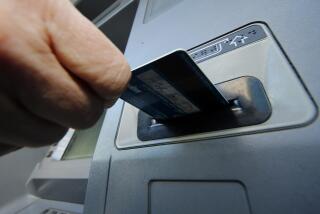Man Suspected in Counterfeiting Ring Is Arrested
- Share via
A Lancaster man who was arrested after he allegedly tried to pay for his McDonald’s meal with a bogus $20 bill is a suspected member of a far-flung counterfeiting ring that has operated for more than a year in the Los Angeles area, authorities said Wednesday.
Alonzo Contreras, 24, was arrested Tuesday after he sped away from the drive-through window of a McDonald’s fast-food restaurant in Acton when a cashier noticed that the bill the customer paid with was a fake, Los Angeles County sheriff’s deputies said.
About $4,500 in counterfeit money was found in the man’s van, after the vehicle was identified from a description provided by McDonald’s employees and was pulled over on the Antelope Valley Freeway, deputies said.
The bogus money is believed to have come from a printing of mostly poor-quality bills that have been circulating in the Los Angeles area for a year, said Clint Howard, special agent in charge of the U.S. Secret Service’s Los Angeles office.
Dozens of counterfeiting arrests have been made over the year and about $30,000 in phony currency has been seized, Howard said. He said in recent weeks the counterfeit bills have been passed numerous times in the Santa Clarita and Antelope valleys.
But investigators have not been able to trace the bills or suspects arrested in the last year to higher echelons of the ring or the source of the counterfeiting, Howard said. Secret Service agents believe the bills are sold for 20 cents on the dollar in mostly Latino neighborhoods and then passed in small amounts at markets and small businesses.
Agents theorize that the bills may have been printed in Mexico and smuggled to this country. Howard said the ring is one of the two largest being investigated by the Secret Service in Los Angeles and the two groups may even be connected because of the similarity in the methods they use.
“This has been a wide-ranging investigation for some time,” Howard said.
Howard said the ink on the bogus bills appears “washed out” when compared to real bills, and the portrait of President Andrew Jackson lacks depth.
“A side-by-side comparison with a real bill shows the counterfeit bill is much poorer quality,” Howard said.
However, he said, counterfeiters have been successful in passing them because the bills are spent at busy businesses for small purchases and often are not scrutinized.
More to Read
Sign up for Essential California
The most important California stories and recommendations in your inbox every morning.
You may occasionally receive promotional content from the Los Angeles Times.













